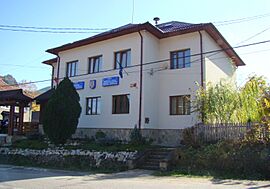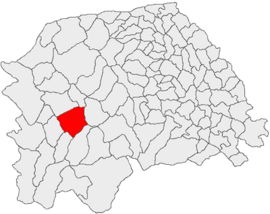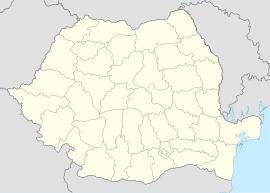Pojorâta facts for kids
Quick facts for kids
Pojorâta
German: Pozoritta or Poschoritta
|
||
|---|---|---|

The town hall of Pojorâta (October 2014)
|
||
|
||

Location in Suceava County
|
||
| Country | ||
| County | Suceava | |
| Population
(2011)
|
Lua error in Module:Wd at line 1,575: attempt to index field 'wikibase' (a nil value). | |
| Time zone | EET/EEST (UTC+2/+3) | |
Pojorâta (which is also known as German: Pozoritta or Poschoritta in German) is a small town, or commune, located in the western part of Suceava County in Romania. It's found in the historical area of Bukovina, which is in the northeastern part of the country.
Pojorâta covers a large area of about 13,770 hectares. It includes the main village of Pojorâta, which is like its center, and another village called Valea Putnei.
A Look Back in Time
![]() Moldavia (1388–1775)
Moldavia (1388–1775)
![]() Habsburg Monarchy (1775–1804)
Habsburg Monarchy (1775–1804)
![]() Austrian Empire (1804–1867)
Austrian Empire (1804–1867)
![]() Austria-Hungary, Cisleithania (1867–1918)
Austria-Hungary, Cisleithania (1867–1918)
![]() Kingdom of Romania (1918–1947)
Kingdom of Romania (1918–1947)
![]() Romanian People's Republic (1947–1965)
Romanian People's Republic (1947–1965)
![]() Socialist Republic of Romania (1965–1989)
Socialist Republic of Romania (1965–1989)
![]() Romania (1989–present)
Romania (1989–present)
The history of Pojorâta is very interesting! This area was once known for its mines. Because of this, many people moved here to work.
For a long time, a group of German people lived in Pojorâta. They were called Zipser Germans, and they were part of a larger group of Bukovina Germans. They started living here a long time ago, during the time of the Habsburg Empire and later the Austro-Hungarian Empire. They stayed in Pojorâta until the middle of the 20th century.
The box on the right shows which countries or empires ruled Pojorâta throughout history. It started with Moldavia in 1388. Then, it became part of the Habsburg Monarchy, the Austrian Empire, and Austria-Hungary. Finally, in 1918, it joined the Kingdom of Romania. Pojorâta has been part of Romania ever since, through different periods of its government.
Gallery
See also
 In Spanish: Pojorâta para niños
In Spanish: Pojorâta para niños














